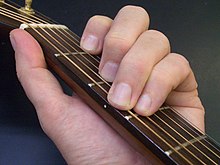Our website is made possible by displaying online advertisements to our visitors.
Please consider supporting us by disabling your ad blocker.
Chord (music)
This article has multiple issues. Please help improve it or discuss these issues on the talk page. (Learn how and when to remove these messages)
|

In Western music theory, a chord is a group[a] of notes played together for their harmonic consonance or dissonance. The most basic type of chord is a triad, so called because it consists of three distinct notes: the root note along with intervals of a third and a fifth above the root note.[1] Chords with more than three notes include added tone chords, extended chords and tone clusters, which are used in contemporary classical music, jazz, and other genres.
Chords are the building blocks of harmony and form the harmonic foundation of a piece of music. They provide the harmonic support and coloration that accompany melodies and contribute to the overall sound and mood of a musical composition. The factors, or component notes, of a chord are often sounded simultaneously but can instead be sounded consecutively, as in an arpeggio.
A succession of chords is called a chord progression.[2] One example of a widely used chord progression in Western traditional music and blues is the 12 bar blues progression. Although any chord may in principle be followed by any other chord, certain patterns of chords are more common in Western music, and some patterns have been accepted as establishing the key (tonic note) in common-practice harmony—notably the resolution of a dominant chord to a tonic chord. To describe this, Western music theory has developed the practice of numbering chords using Roman numerals[3] to represent the number of diatonic steps up from the tonic note of the scale.
Common ways of notating or representing chords[4] in Western music (other than conventional staff notation) include Roman numerals, the Nashville Number System, figured bass, chord letters (sometimes used in modern musicology), and chord charts.
Cite error: There are <ref group=lower-alpha> tags or {{efn}} templates on this page, but the references will not show without a {{reflist|group=lower-alpha}} template or {{notelist}} template (see the help page).
- ^ Hutchinson, Robert. "Introduction to Triads". Music Theory for the 21st-Century Classroom. University of Puget Sound.
- ^ Moylan 2014, p. 39.
- ^ Schoenberg 1983, pp. 1–2.
- ^ Benward & Saker 2003, p. 77.
Previous Page Next Page


